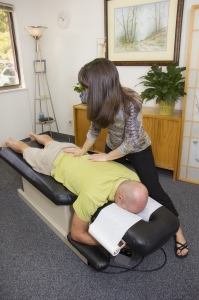My approach to Back Pain Treatment:
Despite similarities, I have found that everyone has their own unique back pain situation. As a back pain therapist it is my goal to return the patient to healthy movement as soon as tolerable. Often it is inactivity followed by increased activity that brings on back pain or back injuries in the first place.
Back treatment addressing comfort and functionality in supporting muscles will go a lot further than simply targeting the area in pain. My goal is to take stress off the injured area and create the best environment for healing. Once we reach a state of optimal healing I can begin working to restore function to the injured area.
Every effective back pain treatment program incorporates a proactive movement and strength plan.
Back Pain defined by the Mayo Clinic:
Back pain is a very common complaint. In fact, most people in the United States will complain of lower back pain sometimes throughout their lives. Although this type of pain is so common, there are plenty of preventative measures that one can take to either prevent or lessen back pain.
Common symptoms of back pain include:
- Muscle aches
- Shooting or stabbing pain
- Pain that spreads down your leg
- Limited flexibility or range of motion
- Inability to stand up straight
Most back pain will improve with home treatment and self-care. Back pain can sometimes take several weeks to go away entirely, however you should notice improvement within the first three days of self-care.
Upper back pain can occur anywhere from the base of your neck to the bottom of your rib cage. Upper back pain is not as common as lower back pain. This type of back pain can be caused by overuse, muscle strain, or injury to the muslces ligaments or discs that support the spine. Poor posture, pressure on the spinal nerves, a fracture, osteoarthritis or Myofascial pain can all cause upper back pain.
Lower back pain can occur anywhere below the ribcage and above the legs. Lower back pain is the most common type of back pain. Causes of lower back pain include: overuse, strain, injury, aging, herniated disc, arthritis, compression fractures, illness or spine issues you were born with.
Occasionally, back pain can signal a more serious medical issue. You should seek immediate medical care if you notice that you have:
- New bowel or bladder problems
- Pain is associated with pain or throbbing in the abdomen
- Pain is associated with a fever
- Pain occurs after a fall or blow to your back or other injury
You may want to schedule an appointment with your doctor if your back pain:
- Is constant or intense
- Spreads down one or both legs
- Causes weakness, numbness or tingling in one or both legs
- Is accompanied by unexplained weight loss
- Occurs with redness or swelling on your back
Anyone can develop pack pain, including children and teens. Known causes of back pain include:
- Muscle or ligament strain
- Bulging or ruptured disks
- Arthritis
- Skeletal irregularities
- Osteoporosis
- Excess weight
- Lack of exercise
- Improper lifting
Doctors typically recommend pain relievers such as Tylenol, Advil, Motrin or Aleve for back pain. If mild to moderate back pain doesn’t improve with the use of these medications, your doctor might prescribe a muscle relaxant. Physical therapy is often prescribed when treating back pain as the physical therapist can use a variety of treatments to help reduce the pain. Chiropractic care is another common treatment that people with back pain often seek. Chiropractic care helps restore function and relieve pain.
Mayo Clinic (2014). Back Pain. http://www.mayoclinic.org/diseases-conditions/back-pain/basics/definition/con-20020797
